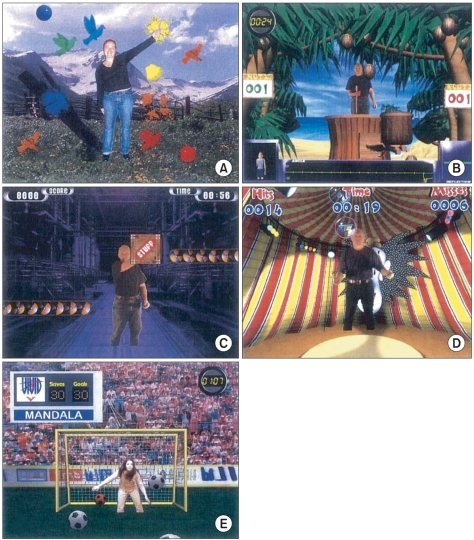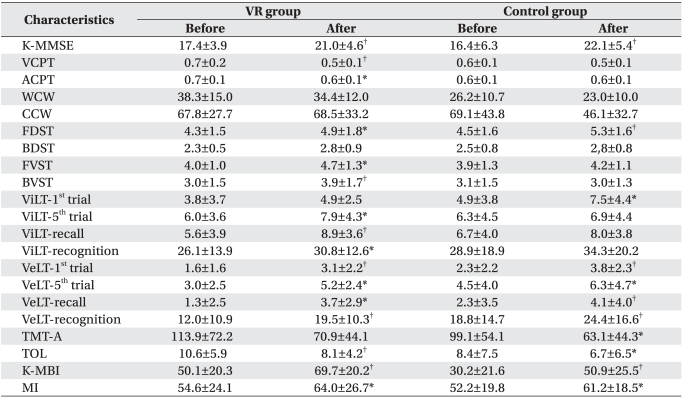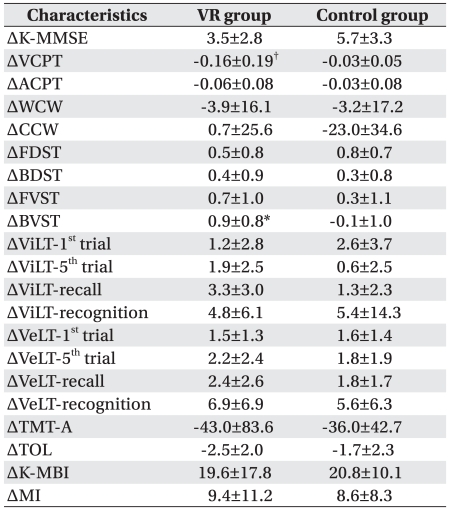1. Leys D, Henon H, Pasquier F. White matter changes and poststroke dementia. Dement Geriatr Cogn Disord 1998;9(Suppl 1): 25-29. PMID:
9716241.

2. Pohjasvaara T, Erkinjuntti T, Vataja R, Kaste M. Dementia three months after stroke. Baseline frequency and effect of different definitions of dementia in the Helsinki Stroke Aging Memory Study (SAM) cohort. Stroke 1997;28:785-792. PMID:
9099197.


3. Cicerone KD, Dahlberg C, Kalmar K, Langenbahn DM, Malec JF, Berquist TF, Felicetti T, Giacino JT, Harley JP, Harrington DE, et al. Evidence-based cognitive rehabilitation: recommendations for clinical practice. Arch Phys Med Rehabil 2000;81:1596-1615. PMID:
11128897.


4. Gontkovsky ST, McDonald NB, Clark PG, RuWe WD. Current directions in computer-assisted cognitive rehabilitation. Neurorehabilitation 2002;17:195-199. PMID:
12237499.


5. Diamond PT, Felsenthal G, Maccinocchi SN, Butler DH, Lally-Cassady D. Effect of cognitive impairment on rehabilitation outcome. Am J Phys Med Rehabil 1996;75:40-43. PMID:
8645438.


6. Glisky EL, Schacter DL, Tulving E. Learning and retention of compter-related vocabulary in memory-impaired patients: method of vanishing cues. J Clin Exp Neuropsychol 1986;8:292-312. PMID:
3755140.


7. Chen SH, Thomas JD, Glueckauf RL, Bracy OL. The effectiveness of computer-assisted cognitive rehabilitation for persons with traumatic brain injury. Brain injury 1997;11:197-209. PMID:
9058001.


8. Niemann H, Ruff RM, Base CA. Computer-assisted attention retraining in head-injured individuals: a controlled efficacy study of an outpatient program. J Consult Clin Psychol 1990;58:811-817. PMID:
2292631.



9. Kim YH, Ko MH, Seo JH, Park SH, Kim KS, Jang EH, Park SW, Park JH, Cho YJ. Effect of computer-assisted cognitive rehabilitation program for attention training in brain injury. J Korean Acad Rehabil Med 2003;27:830-839.
10. Parsons TD, Rizzo AA. Initial validation of a virtual environment for assessment of memory functioning: virtual reality cognitive performance assessment test. Cyberpsychol Behav 2008;11:17-25. PMID:
18275308.


11. Parsons TD, Rizzo AA. Neurpsychological assessment using the virtual reality cognitive performance assessment test. Proceedings of the 7th ICDVRAT with Art-Abilitation 2008;2008 Aug 31-Sep 2; Maia, Portugal. UK, University of Reading.
12. Parsons TD, Larson P, Kratz K, Thiebaux M, Bluestein B, Buckwalter JG, Rizzo AA. Sex differences in mental rotation and spatial rotation in a virtual environment. Neuropsychologia 2004;42:555-562. PMID:
14728927.


13. Matheis RJ, Schultheis MT, Tiersky LA, Deluca J, Millis SR, Rizzo A. Is learning and memory different in a virtual environment? Clin Neuropsychol 2007;21:146-161. PMID:
17366282.


14. Hofmann M, Rosler A, Schwarz W, Muller-Spahn F, Krauchi K, Hock C, Seifritz E. Interactive computer-training as a therapeutic tool in Alzheimer's disease. Compr Psychiatry 2003;44:213-219. PMID:
12764709.


15. Cushman LA, Stein K, Duffy CJ. Detecting navigational deficits in cognitive aging and Alzheimer disease using virtual reality. Neurology 2008;71:888-895. PMID:
18794491.



17. Werner P, Rabinowitz S, Klinger E, Korczyn AD, Josman N. Use of the virtual action planning super market for the diagnosis of mild cognitive impairment: a preliminary study. Dement Geriatr Cogn Disord 2009;27:301-309. PMID:
19252401.


18. Optale G, Urgesi C, Busato V, Marin S, Piron L, Priftis K, Gamberini L, Capodieci S, Bordin A. Controlling memory impairment in elderly adults using virtual reality memory training: a randomized controlled pilot study. Neurorehabil Neural Repair 2010;24:348-357. PMID:
19934445.


19. Kim DY, Joo SY, Park CI, Park TH, Par KD, Jung KJ, Lee JH. Assessment of post-stroke cognitive dysfunction using 3-dimensional virtual reality program. J Korean Acad Rehabil Med 2009;33:12-20.
20. Kim DY, Lee JH, Park CI, Kim YW, Chang WH, Kim IY, Kim SI, Chon JS, Chang HJ. Assessment of post-stroke unilateral neglect using 3-dimensional virtual reality program. J Korean Acad Rehabil Med 2005;29:1-8.
21. Kang YJ, Ku JG, Han KW, Kim SI, Yu TW, Lee JH, Park CI. Development and clinical trial of virtual reality-based cognitive assessment in people with stroke: preliminary study. Cyberpsychol Behav 2008;11:329-339. PMID:
18537503.


22. Kim JH, Kim KG, Kim DY, Chang WH, Park CI, Ohn SH, Han KW, Ku JH, Nam SW, Kim IY, et al. Virtual environment training system for rehabilitation of stroke patients with unilateral neglect: crossing the virtual street. Cyberpsychol Behav 2007;10:7-15. PMID:
17305443.


23. Rose FD, Brooks BM, Attree EA, Parslow DM, Leadbetter AG, McNaill JE, Jayawardena S, Greenwood R, Potter J. A preliminary investigation into the use of virtual environments in memory retraining after vascular brain injury: indications for future strategy? Disabil Rehabil 1999;21:548-554. PMID:
10608651.


24. Kim YH, Shin SH, Park SH, Ko MH. Cognitive assessment for patient with brain injury by computerized neuropsychological test. J Korean Acad Rehabil Med 2001;25:209-216.
25. Phillips LH, Wynn V, Gilhooly KJ, Della Sala S, Logie RH. The role of memory in the tower of London task. Memory 1999;7:209-231. PMID:
10645380.


26. Ben-Yishay Y, Piasetsky EB, Rattock J. In: Meier MJ, Benton AL, Diller L, A systematic method for ameliorating disorders in basic attention. editors. Neuropsychological rehabilitation. 1987.1st ed. New York: Churchill Livingstone; p.165-181.
27. Kim MY, Lee KS, Choi JS, Kim HB, Park CI. Effectiveness of cognitive training based on virtual reality for the elderly. J Korean Acad Rehabil Med 2005;29:424-433.
28. Wilson PN, Foreman N, Tlauka M. Transfer of spatial information from a virtual to a real environment in physically disabled children. Disabil Rehabil 1996;18:633-637. PMID:
9007423.


29. Stanton D, Foreman N, Wilson P, Duffy H, Parnell R. Use of virtual environments to acquire spatial under standing of real-world multi-level environments. Proceedings of the 4th International Conference on Disability, Virtual Reality and associated Technologies 2002;2002 Sep 18-20; Veszprem, Hungary. UK, University of Reading.
30. Fordyce DE, Farrar RP. Enhancement of spatial learning in F344 rats by physical activity and related learning-associated alterations in hippocampal and cortical cholinergic functioning. Behav Brain Res 1991;46:123-133. PMID:
1664728.


31. Grealy MA, Johnson DA, Rushton SK. Improving cognitive function after brain injury: the use of exercise and virtual reality. Arch Phys Med Rehabil 1999;80:661-667. PMID:
10378492.


32. Castiello U, Lusher D, Burton C, Glover S, Disler P. Improving left hemispatial neglect using virtual reality. Neurology 2004;62:1958-1962. PMID:
15184596.


33. Glover S, Castiello U. Recovering space in unilateral neglect: a neurological dissociation revealed by virtual reality. J Cogn Neurosci 2006;18:833-843. PMID:
16768381.













